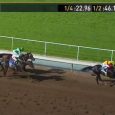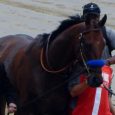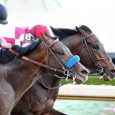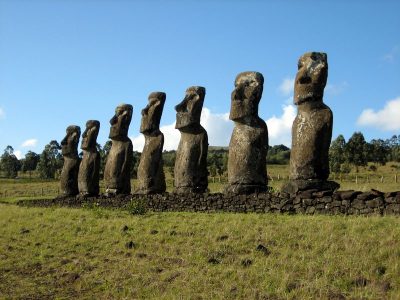 Of all the great mysteries in the world — the origin of the stone statues on Easter Island, the existence/location of the Holy Grail, the person(s) responsible for letting the dogs out — few have led to more head-scratching and frustrated tears than the annual question of how fast or slow the Kentucky Derby pace will be.
Of all the great mysteries in the world — the origin of the stone statues on Easter Island, the existence/location of the Holy Grail, the person(s) responsible for letting the dogs out — few have led to more head-scratching and frustrated tears than the annual question of how fast or slow the Kentucky Derby pace will be.
This year is no exception.
Will Danzing Candy jet to the front like he did in the Santa Anita Derby? Will Nyquist show the early foot he did in the FrontRunner as a juvenile? Or will Outwork outgun them all and make a beeline to the head of the pack?
I would like to be able to answer these questions definitively… I would also like to run faster than a speeding bullet and leap tall buildings with a single bound. But, like I said earlier, figuring the Derby pace is one of life’s great mysteries. Nonetheless, there are clues from past editions of the Run for the Roses that can aid us in this daunting quest.
As many regular readers know, I make my own pace figures… well, actually, they are more like energy figures, similar to those popularized by Tom Brohamer in his book “Modern Pace Handicapping.”
Most racing fans understand that different types of races have different kinds of energy requirements, based on distance, surface and even track or race configuration. It is also understood by most fans that certain horses expend their energy in very specific ways. That’s what my speed rations attempt to measure.
Danzing Candy, for instance, knows just one path to the winner’s circle — and that’s to run as fast as he can for as far as he can.

Hence, it would seem that a good way to determine the pace of the Kentucky Derby is to simply focus on the best (lowest) recent early speed rations recorded by all the entrants, right?
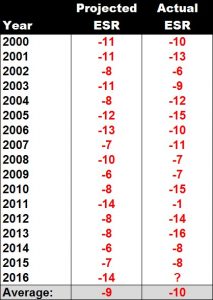 Wrong.
Wrong.
Although using the top ESRs to project the pace of the Most Exciting Two Minutes in Sports is fairly accurate on the whole, the technique fails miserably on a race-by-race basis, as the chart on the left aptly demonstrates.
This was particularly true in 2011, when the projected Derby ESR was a blistering -14, yet Shackleford waltzed through the opening half-mile in :48.63 — the slowest such split since 1947, when Jet Pilot wired the field after covering the first four furlongs in 49 seconds flat on a track labeled as “slow.”
Frankly, this is not that surprising. Regardless of how fast a horse is capable of going early, most horses will only run as fast as they need to in order to attain a favorable running position.
This is where Dr. William L. Quirin comes in.
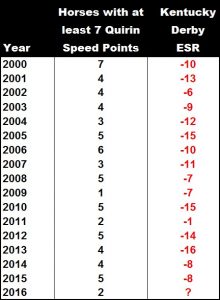 In “Winning at the Races: Computer Discoveries in Thoroughbred Handicapping,” Quirin outlines a simple, yet effective, method of determining the early composition of a race. He assigns points to each horse based on their early running position in each of three “ratable” races. Horses that generally reside in the back of the pack in the early going receive 0-1 points, while animals that typically vie for the lead when the gate springs receive 7-8 points.
In “Winning at the Races: Computer Discoveries in Thoroughbred Handicapping,” Quirin outlines a simple, yet effective, method of determining the early composition of a race. He assigns points to each horse based on their early running position in each of three “ratable” races. Horses that generally reside in the back of the pack in the early going receive 0-1 points, while animals that typically vie for the lead when the gate springs receive 7-8 points.
I have found that not only are these point values useful in identifying Derby contenders and pretenders — horses in the former category are zip-for-78 in Louisville since 1992 — but they also work quite well in determining how contested the pace will be.
Going back to the 2011 Kentucky Derby, you’ll notice that only two horses in the field had 7-8 Quirin speed points and one of those colts — Decisive Moment — had already shown he could rate kindly, as he recorded an extremely soft +1 ESR in the Risen Star. When Comma to the Top also elected to take back a bit leaving the gate on the first Saturday in May, it left Shackleford alone on an easy lead.
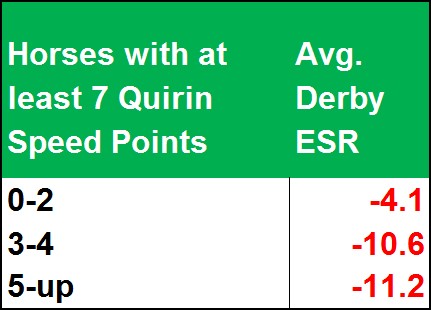 The chart to the left shows just how predictive the presence or absence or early runners is when it comes to deciphering the Kentucky Derby pace.
The chart to the left shows just how predictive the presence or absence or early runners is when it comes to deciphering the Kentucky Derby pace.
This year, only a couple of likely Derby starters possess at least seven Quirin speed points: the aforementioned Danzing Candy and Outwork, the front running winner of the Wood Memorial.
To me, everything hinges on whether Danzing Candy can — or will — relax.
On my April 23 podcast, jockey Mike Smith told me that he typically hustles the son of Twirling Candy out of the gate and then shuts him down. However, the Hall of Fame rider concedes that all did not go according to plan in the Santa Anita Derby.
“I was a little aggressive with him leaving [the gate] and when I went put my hands down to shut him down, he just flat took off,” Smith said.
Danzing Candy earned a -15.95 ESR in the SA Derby, which, for the sake of perspective, rivals the lowest (fastest) ESR ever recorded in the Run for the Roses — a -15.96 by Groovy in 1986. The problem, at least for me, is that Danzing Candy didn’t go that much slower in the San Felipe (-11.55) and, in fact, he’s never recorded an ESR greater (slower) than the Derby par in any of his two-turn tries.
If he insists on running free in Louisville — and, on that same April 23 podcast, Smith told me that he’s not a fan of fighting a horse early (which I think is generally wise) — I think it will create that “giant sucking sound” that Ross Perot once warned us about, as Outwork, Destin, Shagaf and maybe even Nyquist will rush to fill the vacuum.
So, the bottom line on the Derby pace is this: It could be fast, it could be slow… and I’m definitely going to need some gauze for my scalp.



